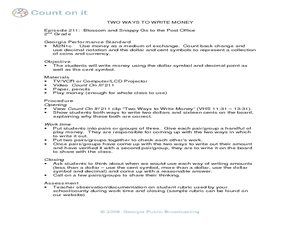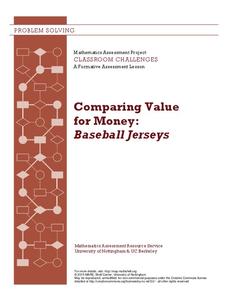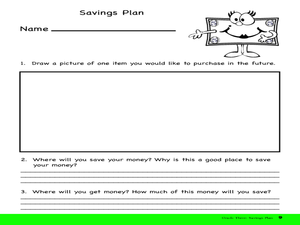Curated OER
Making Good Money Choices
Student explore an economic-decision making model to decide where to donate money they have collected. In this philanthropic money lesson, students develop a plan for raising money and then decide how to best spend it for the most...
Curated OER
Money
In this ESL activity, students study US currency. Students respond to 20 questions orally and complete 4 various role play scenarios.
Curated OER
Whose money is it?
Students perform research on the Web, in books and by contacting lawyers to find out what steps the court goes through to decide who gets the money. They create a chart to illustrate what laws or policies the court follows.
Curated OER
Shared and Guided Reading with Ice Cream Money
Here is a lesson plan which has young scholars locate an exclamation point and a comma from the text. They locate previously learned words on the page, and create a word map from the word "Money." Students write about and illustrate...
Curated OER
Real-Life Problems
How much does it cost to mail this letter? Scholars approach the real-life scenario of adding postage as they practice introductory addition. Each letter has a total amount it needs, and learners draw in the appropriately-priced stamps...
Curated OER
Bible Lesson
Take a creative approach to teaching about community in a religious context. Learners read Acts 2:42-47 and choose the verse they feel exemplify the importance of community. They then pair share, write journal responses, and then...
Curated OER
Money Matters
Students explore the concept of money. In this money lesson plan, students role play an economy. Students are divided into three categories- the money factory, construction workers, and the grocery store. Students work cooperatively to...
Curated OER
Two Ways to Write Money
Second graders complete activities to learn about money and how to write money. In this money lesson, 2nd graders watch a video about ways to write money. Students work in groups with play money and come up with two ways to write money....
Curriculum Corner
Menu Math
Getting a meal, side dish, drink, and dessert can be delicious—but it can be expensive too! Practice addition and subtraction with money in a lesson that focuses on a sample menu, complete with task cards and word problems.
Kiwi Crate
Shopping on a Budget
Print some money with a resource on dollars and cents. Combined with a lesson plan about budgeting, the currency includes $1, $5, and $10 bills, coins of varying value, and a platinum credit card.
Curated OER
Comparing Value for Money: Baseball Jerseys
Learners step up to the plate as they first complete an assessment task using linear equations to determine the best company from which to buy baseball jerseys. They then evaluate provided sample responses identifying strengths and...
Federal Reserve Bank
The Story of the Federal Reserve: High School Lesson Plan
Is there a bank for the banks? Pupils analyze the complexities of the Federal Reserve system by breaking it down into easy-to-understand sections. Step-by-step investigation using flow charts and graphs of how the monetary system works...
NASA
MASS, MASS – Who Has the MASS? Analyzing Tiny Samples
What is it worth to you? A hands-on instructional activity asks groups to collect weights of different combinations of coins and calculate weighted averages. They use the analysis to understand the concept of an isotope to finish the...
Mascil Project
Circular Pave-Stones Backyard
Pack the lesson into your plans. Young mathematicians learn about packing and optimization with the context of circular paving stones. They use coins to model the paving stones, and then apply knowledge of circles and polygons to...
Federal Reserve Bank
Once Upon a Dime: Middle School Lesson Plan
Once Upon a Dime ... a group of middle schoolers wanted to learn about economics! Teach them complex economic concepts like supply and demand through a resource that effectively simplifies the explanations. Pupils work through various...
US Department of Commerce
Featured Activity: Exploring Questions for the 2020 Census
Just what is the census for? Using data and census questions, class members explore how officials gather information. Then, they consider how the government uses the answers to determine how it spends its money with a collaborative...
Curated OER
Saving and Investing
Fifth graders participate in activities to promote understanding of investing and saving. In this saving and investing lesson, 5th graders design a portfolio, play a card game and write a skit about the importance of investing.
Curated OER
Making Choices
Second graders explore financial decision making. In this introductory economics lesson, 2nd graders listen to the book Alexander, Who Used to be Rich Last Sunday by Judith Viorst, and discuss making financial choices based on wants and...
Curated OER
Having a Savings Plan
Young scholars discover the importance of saving and spending. In this finance lesson, students read the book Kermit the Hermit and discuss the differences between needs and wants. The young scholars complete worksheets concerning money...
Curated OER
How Much Is It?
Students explore foreign currencies. In this foreign currencies lesson, students simulate travel to another country and determine the value of the US dollar compared to other countries. Students use a conversion table and search Internet...
Curated OER
Common Sense Cookie Shop
First graders shop for a bag of cookies using toy money. In teams, they choose which variety to buy and decides which bills and coins are necessary to buy the bag of cookies and a cashier makes change. They tally the cookies purchased...
Curated OER
Super Bucks
Students examine paper currency for its artistic value. They design their own piece of currency based on the artistic methods used in the design of real money.
Curated OER
Labor, Choice, and Sales Tax
Learners consider the idea of earning and spending money. For this money management lesson plan, students discuss the concept of saving and spending money through the reading of a story and by completing several activities that involve...
Curated OER
Making Change
Second graders explore how to incorporate a new type of technology, the cash register and/or a calculator, as a motivational tool for solving real life problems. They practice estimating money and counting back change from $20.00.
Other popular searches
- Money Lessons Giving Change
- Counting Money Lessons
- Canadian Money Lessons
- Second Grade Money Lessons
- 2nd Grade Money Lessons
- Australian Money Lessons
- Shopping Money Lessons
- Math Money Lessons
- Money Lessons Elementary
- Fun Money Lessons
- Counting Money Math Lessons
- Adding Money Amounts Lessons

























